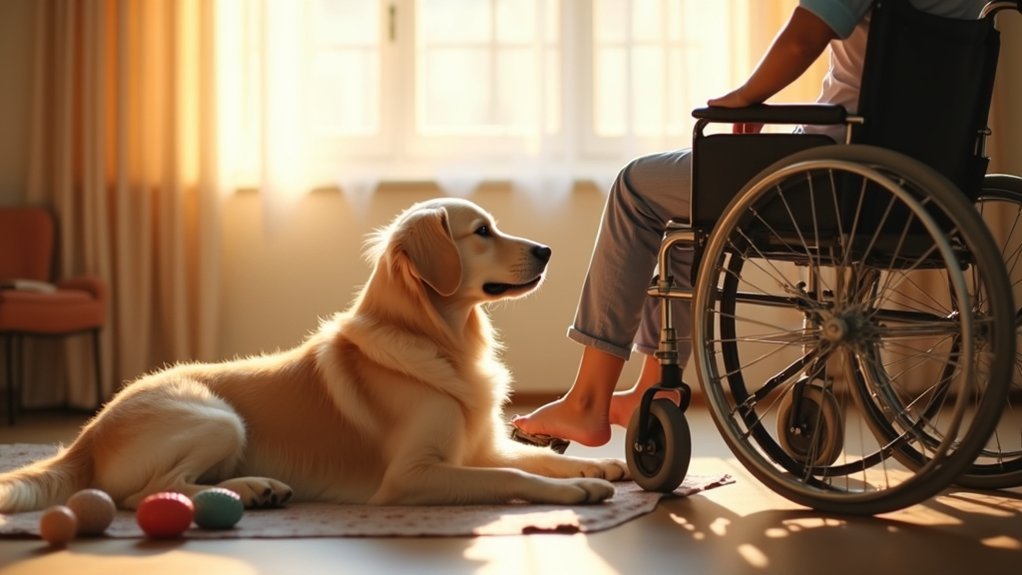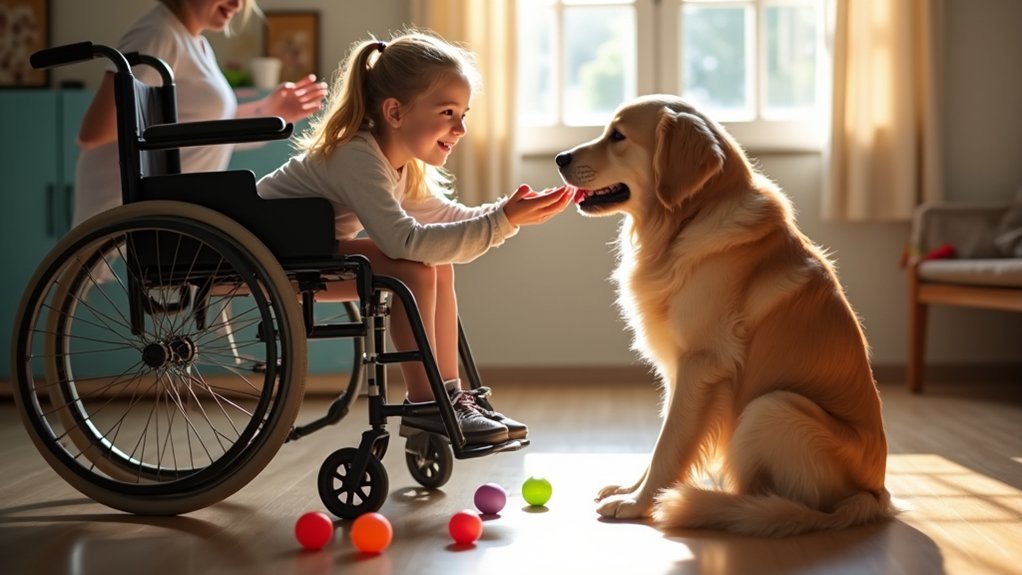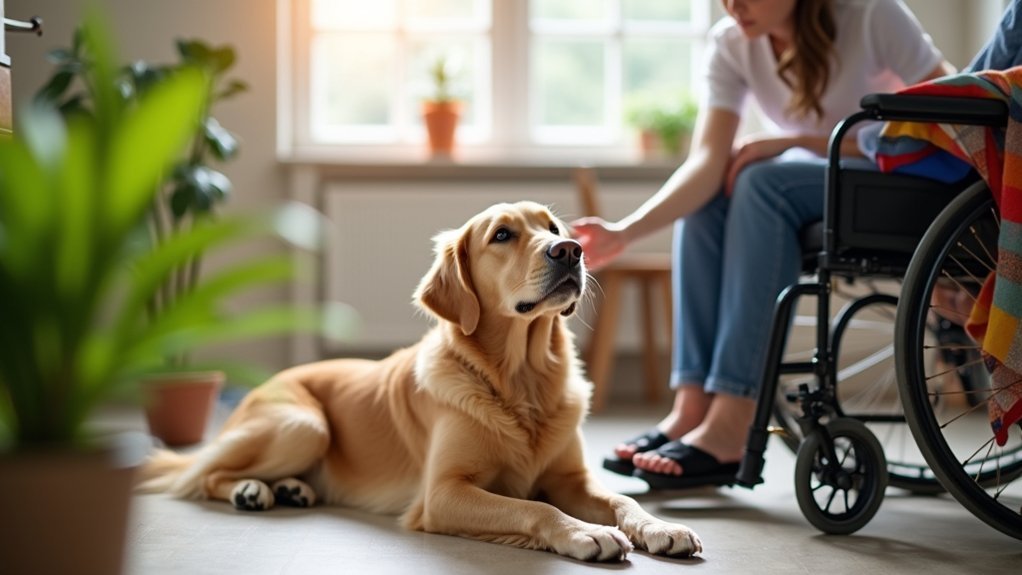Animal therapy can greatly boost your paralysis recovery journey. Select an animal suited to your specific goals—dogs for physical rehabilitation, cats for calming support, or horses for balance improvement. Build a strong bond through consistent, positive interactions. Engage in targeted activities like walking with therapy dogs or grooming sessions to enhance motor skills. Coordinate animal therapy with your medical team for a thorough approach. Track your progress and celebrate even small victories to maintain motivation throughout your healing process.
Finding the Right Therapy Animal for Your Recovery Needs

When starting on your paralysis recovery journey, finding the right therapy animal can greatly impact your progress and well-being.
Consider your specific recovery goals before choosing an animal companion. Dogs excel at forming strong bonds and can assist with physical rehabilitation exercises, while cats provide calming support with minimal maintenance requirements.
For physical therapy needs, horses offer unique benefits through equine therapy, helping with balance and core strength. These animal interactions can trigger endorphin release that naturally counteracts pain during challenging rehabilitation sessions.
If you’re dealing with anxiety or depression alongside physical recovery, smaller animals like rabbits can provide tactile comfort without overwhelming you.
Your therapy animal should match your living situation, physical capabilities, and emotional needs.
Work with a trained therapist to assess which animal characteristics—temperament, size, training level—will best support your specific paralysis recovery challenges.
Building a Therapeutic Bond With Your Animal Companion
The foundation of successful animal therapy lies in establishing a meaningful connection with your therapy animal. This bond develops through consistency in your interactions and clear boundary setting. Rather than dominating, focus on compassionate leadership that builds trust over time.
Create a safe environment where both you and your animal companion can thrive. Regular, positive reinforcement strengthens your connection while tailoring activities to your specific recovery needs enhances engagement. Incorporating simple trick training activities can mentally stimulate your therapy animal while creating a no-pressure environment for your recovery work.
Safety and mutual growth form the foundation of successful animal therapy, strengthened through positive reinforcement and personalized activities.
Pay attention to non-verbal cues—your body language communicates volumes to your therapy animal.
As you work through paralysis recovery, this therapeutic relationship offers emotional support, stress reduction, and opportunities for expressing feelings in a judgment-free space.
Monitor your progress together and adapt your approach as your needs evolve throughout the recovery journey.
Daily Activities to Enhance Motor Skills Through Animal Interaction

Incorporating five key animal-assisted activities into your daily routine can considerably accelerate motor skill recovery during paralysis rehabilitation.
Start with walking exercises alongside a trained therapy dog, using their stability to practice balance and gait. Engage in play sessions that target specific motor functions—tossing balls or using puzzle toys to improve dexterity and coordination.
Make animal grooming part of your therapy; brushing a pet works fine motor skills and extends your range of motion. Remember that nerve regeneration occurs slowly, so maintain these activities even when progress isn’t immediately visible.
Practice reaction exercises by responding to your animal’s movements and sounds, which helps rebuild neural pathways.
Finally, schedule outdoor exploration with your animal companion to combine physical therapy with sensory stimulation in varied environments.
These activities maintain consistency while providing the motivational support that makes rehabilitation exercises more engaging and effective.
Integrating Animal Therapy With Your Rehabilitation Program
Successfully integrating animal therapy into your rehabilitation program requires thoughtful coordination between your medical team and animal therapy specialists. Discuss your specific recovery goals with both teams so they can tailor animal interactions to address your unique needs, whether improving mobility, strength, or emotional well-being.
When scheduling sessions, make sure they complement your existing physical, occupational, or speech therapy appointments rather than creating conflicts. You’ll benefit most when animal therapy reinforces other rehabilitation efforts.
Request regular progress evaluations to measure improvements and adjust your program accordingly. Brief interactions with therapy animals can significantly increase oxytocin levels while decreasing stress hormones, creating an optimal physiological state for rehabilitation.
Don’t hesitate to provide feedback about your preferences and comfort level with different animals or activities. The most effective rehabilitation occurs when therapy is customized to your situation, maximizing motivation while creating a stress-reducing environment that supports your recovery journey.
Measuring Progress and Celebrating Milestones With Animal Assistance

Tracking your recovery journey with animal therapy provides both measurable results and meaningful moments worth celebrating. Use standardized tools like the Gross Motor Function Measure to quantify improvements in your gait, balance, and muscle strength during therapy sessions.
Equine-assisted therapy particularly enhances movement quality, with benefits often lasting beyond your sessions.
Don’t overlook the emotional progress—animals create natural opportunities for social interaction and cognitive stimulation that complement your physical gains. The therapeutic intervention can be tailored to address specific individual needs based on your rehabilitation goals and preferences.
Different animals offer unique benefits: horses excel at improving gross motor functions, while dogs provide emotional support during challenging exercises.
Work with your rehabilitation team to integrate animal therapy into your personalized recovery plan.
When you achieve milestones, celebrate them—these achievements reflect progress in both your physical abilities and mental wellbeing.
Frequently Asked Questions
How Do Insurance Companies Typically Cover Animal Therapy Expenses?
Most insurance companies require additional coverage for animal therapy expenses. You’ll need to purchase wellness or alternative therapy plans, though some like Embrace Pet Insurance include complementary treatments at no extra cost.
Can Therapy Animals Assist Patients With Communication Disorders?
Yes, therapy animals can definitely help if you have a communication disorder. They’ll reduce your anxiety, increase your motivation, and enhance social interaction during therapy. You’ll likely experience improved verbal and nonverbal communication skills.
What Alternatives Exist for Patients With Animal Allergies?
If you’re allergic to animals, you can try virtual reality therapy, robotic pets, AI tools, or hydrotherapy. Air purification systems, art therapy, and mindfulness practices also offer effective alternatives without triggering allergic reactions.
How Do Therapy Animals Interact With Home Care Medical Equipment?
You’ll need to train therapy animals to navigate around medical equipment safely. They’re taught to avoid tubes and wires, while handlers guarantee they don’t disrupt essential devices during therapeutic interactions.
What Specialized Training Helps Animals Work With Paralyzed Patients?
Animals receive specialized training in physical support, mobility assistance, and responding to limited mobility. You’ll find they’re conditioned to remain calm with medical equipment and provide emotional support during rehabilitation exercises for paralyzed patients.
In Summary
As you continue your paralysis recovery journey, remember that your therapy animal is more than a companion—they’re a catalyst for healing. You’ll find their unconditional support empowers your determination each day. Trust the process, adapt activities as needed, and celebrate every small victory together. With patience and your animal partner by your side, you’re creating a unique path toward improved mobility and independence.





Leave a Reply